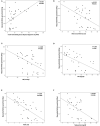Metabolic Syndrome Is Associated With Impaired Insulin-Stimulated Myocardial Glucose Metabolic Rate in Individuals With Type 2 Diabetes: A Cardiac Dynamic 18F-FDG-PET Study
- PMID: 35845046
- PMCID: PMC9276995
- DOI: 10.3389/fcvm.2022.924787
Metabolic Syndrome Is Associated With Impaired Insulin-Stimulated Myocardial Glucose Metabolic Rate in Individuals With Type 2 Diabetes: A Cardiac Dynamic 18F-FDG-PET Study
Abstract
Metabolic syndrome is a condition characterized by a clustering of metabolic abnormalities associated with an increased risk of type 2 diabetes and cardiovascular disease. An impaired insulin-stimulated myocardial glucose metabolism has been shown to be a risk factor for the development of cardiovascular disease in patients with type 2 diabetes. Whether cardiac insulin resistance occurs in subjects with metabolic syndrome remains uncertain. To investigate this issue, we evaluated myocardial glucose metabolic rate using cardiac dynamic 18F-FDG-PET combined with euglycemic-hyperinsulinemic clamp in three groups: a group of normal glucose tolerant individuals without metabolic syndrome (n = 10), a group of individuals with type 2 diabetes and metabolic syndrome (n = 19), and a group of subjects with type 2 diabetes without metabolic syndrome (n = 6). After adjusting for age and gender, individuals with type 2 diabetes and metabolic syndrome exhibited a significant reduction in insulin-stimulated myocardial glucose metabolic rate (10.5 ± 9.04 μmol/min/100 g) as compared with both control subjects (32.9 ± 9.7 μmol/min/100 g; P < 0.0001) and subjects with type 2 diabetes without metabolic syndrome (25.15 ± 4.92 μmol/min/100 g; P = 0.01). Conversely, as compared with control subjects (13.01 ± 8.53 mg/min x Kg FFM), both diabetic individuals with metabolic syndrome (3.06 ± 1.7 mg/min × Kg FFM, P = 0.008) and those without metabolic syndrome (2.91 ± 1.54 mg/min × Kg FFM, P = 0.01) exhibited a significant reduction in whole-body insulin-stimulated glucose disposal, while no difference was observed between the 2 groups of subjects with type 2 diabetes with or without metabolic syndrome. Univariate correlations showed that myocardial glucose metabolism was positively correlated with insulin-stimulated glucose disposal (r = 0.488, P = 0.003), and negatively correlated with the presence of metabolic syndrome (r = -0.743, P < 0.0001) and with its individual components. In conclusion, our data suggest that an impaired myocardial glucose metabolism may represent an early cardio-metabolic defect in individuals with the coexistence of type 2 diabetes and metabolic syndrome, regardless of whole-body insulin resistance.
Keywords: cardiac 18F-FDG-PET; cardiovascular disease; insulin resistance; metabolic syndrome; myocardial glucose metabolism; type 2 diabetes.
Copyright © 2022 Succurro, Vizza, Papa, Cicone, Monea, Tradigo, Fiorentino, Perticone, Guzzi, Sciacqua, Andreozzi, Veltri, Cascini and Sesti.
Conflict of interest statement
The authors declare that the research was conducted in the absence of any commercial or financial relationships that could be construed as a potential conflict of interest.
Figures


Similar articles
-
Impaired insulin-stimulated myocardial glucose metabolic rate is associated with reduced estimated myocardial energetic efficiency in subjects with different degrees of glucose tolerance.Cardiovasc Diabetol. 2023 Jan 9;22(1):4. doi: 10.1186/s12933-022-01733-z. Cardiovasc Diabetol. 2023. PMID: 36624469 Free PMC article.
-
Reduction in Global Myocardial Glucose Metabolism in Subjects With 1-Hour Postload Hyperglycemia and Impaired Glucose Tolerance.Diabetes Care. 2020 Mar;43(3):669-676. doi: 10.2337/dc19-1975. Epub 2020 Jan 23. Diabetes Care. 2020. PMID: 31974102
-
Elevated whole blood viscosity is associated with an impaired insulin-stimulated myocardial glucose metabolism.Cardiovasc Diabetol. 2024 Dec 4;23(1):431. doi: 10.1186/s12933-024-02513-7. Cardiovasc Diabetol. 2024. PMID: 39633361 Free PMC article.
-
Impaired insulin sensitivity measured by estimated glucose disposal rate is associated with decreased myocardial mechano-energetic efficiency in non-diabetic individuals.Eur J Intern Med. 2024 Dec;130:144-150. doi: 10.1016/j.ejim.2024.09.008. Epub 2024 Sep 16. Eur J Intern Med. 2024. PMID: 39289108
-
Metabolism and insulin signaling in common metabolic disorders and inherited insulin resistance.Dan Med J. 2014 Jul;61(7):B4890. Dan Med J. 2014. PMID: 25123125 Review.
Cited by
-
Cardiac Insulin Resistance in Subjects With Metabolic Syndrome Traits and Early Subclinical Atherosclerosis.Diabetes Care. 2023 Nov 1;46(11):2050-2057. doi: 10.2337/dc23-0871. Diabetes Care. 2023. PMID: 37713581 Free PMC article.
-
Sex-specific differences in myocardial glucose metabolic rate in non-diabetic, pre-diabetic and type 2 diabetic subjects.Cardiovasc Diabetol. 2024 Apr 26;23(1):144. doi: 10.1186/s12933-024-02246-7. Cardiovasc Diabetol. 2024. PMID: 38671460 Free PMC article.
-
Insights into Insulin Resistance and Calcification in the Myocardium in Type 2 Diabetes: A Coronary Artery Analysis.Int J Mol Sci. 2023 Feb 7;24(4):3250. doi: 10.3390/ijms24043250. Int J Mol Sci. 2023. PMID: 36834662 Free PMC article.
-
Effect of Gegen Qinlian Decoction combined with dietary management on patients with damp-heat Type-2 diabetes mellitus and metabolic syndrome.Pak J Med Sci. 2024 Aug;40(7):1523-1528. doi: 10.12669/pjms.40.7.9476. Pak J Med Sci. 2024. PMID: 39092028 Free PMC article.
-
Human cardiac metabolism.Cell Metab. 2024 Jul 2;36(7):1456-1481. doi: 10.1016/j.cmet.2024.06.003. Cell Metab. 2024. PMID: 38959861 Free PMC article. Review.
References
LinkOut - more resources
Full Text Sources

